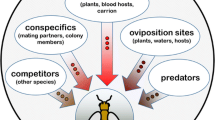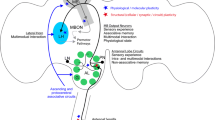Abstract
Alarm pheromones are important semiochemicals used by many animal species to alert conspecifics or other related species of impending danger. In this review, we describe recent developments in our understanding of the neural mechanisms underlying the ability of fruit flies, zebrafish and mice to mediate the detection of alarm pheromones. Specifically, alarm pheromones are detected in these species through specialized olfactory subsystems that are unique to the chemosensitive receptors, second messenger-signaling and physiology. Thus, the alarm pheromones appears to be detected by signaling mechanisms that are distinct from those seen in the canonical olfactory system.
Similar content being viewed by others
References
Blumberg, M.S., Efimova, I.V., and Alberts, J.R. (1992). Ultrasonic vocalizations by rat pups: the primary importance of ambient temperature and the thermal significance of contact comfort. Dev. Psychobiol. 25, 229–250.
Braubach, O.R., Fine, A., and Croll, R.P. (2012). Distribution and functional organization of glomeruli in the olfactory bulbs of zebrafish (Danio rerio). J. Comp. Neurol. 520, 2317–2339- Spc2311.
Brechbühl, J., Klaey, M., and Broillet, M.-C. (2008). Grueneberg ganglion cells mediate alarm pheromone detection in mice. Science 321, 1092–1095.
Breer, H., Fleischer, J., and Strotmann, J. (2006). The sense of smell: multiple olfactory subsystems. Cell. Mol. Life Sci. 63, 1465–1475.
Brown, G.E., Adrian, J., James, C., Smyth, E., Leet, H., and Brennan, S. (2000). Ostariophysan alarm pheromones: laboratory and field tests of the functional significance of nitrogen oxides. J. Chem. Ecol. 26, 139–154.
Carr, W.J., Martorano, R.D., and Krames, L. (1970). Responses of mice to odors associated with stress. J. Comp. Physiol. Psych. 71, 223–228.
de Bruyne, M., Foster, K., and Carlson, J.R. (2001). Odor coding in the Drosophila antenna. Neuron 30, 537–552.
Dean, P., Redgrave, P., and Westby, G.W. (1989). Event or emergency? Two response systems in the mammalian superior colliculus. Trends Neurosci. 12, 137–147.
Dill, L.M., Fraser, A.H.G., and Roitberg, B.D. (1990). The economics of escape behaviour in the pea aphid, Acyrthosiphon pisum. Oecologia 83, 473–478.
Faucher, C., Forstreuter, M., Hilker, M., and de Bruyne, M. (2006). Behavioral responses of Drosophila to biogenic levels of carbon dioxide depend on life-stage, sex and olfactory context. J. Exp. Biol. 209, 2739–2748.
Fleischer, J., and Breer, H. (2010). The Grueneberg ganglion: a novel sensory system in the nose. Histol. Histopathol. 25, 909–915.
Fleischer, J., Schwarzenbacher, K., Besser, S., Hass, N., and Breer, H. (2006). Olfactory receptors and signalling elements in the Grueneberg ganglion. J. Neurochem. 98, 543–554.
Fleischer, J., Schwarzenbacher, K., and Breer, H. (2007). Expression of trace amine-associated receptors in the Grueneberg ganglion. Chem. Senses 32, 623–631.
Fleischer, J., Mamasuew, K., and Breer, H. (2009). Expression of cGMP signaling elements in the Grueneberg ganglion. Histochem. Cell. Biol. 131, 75–88.
Frisch, K. (1942). Über einen Schreckstoff der Fischhaut und seine biologische Bedeutung. Z. Vergl. Physiol. 29, 46–145.
Gayoso, J., Castro, A., Anadón, R., and Manso, M.J. (2012). Crypt cells of the zebrafish Danio rerio mainly project to the dorsomedial glomerular field of the olfactory bulb. Chem. Senses 37, 357–369.
Gruneberg, H. (1973). A ganglion probably belonging to the N. terminalis system in the nasal mucosa of the mouse. Z. Anat. Entwicklungsgesch 140, 39–52.
Gutierrez-Garcia, A.G., Contreras, C.M., Mendoza-Lopez, M.R., Garcia-Barradas, O., and Cruz-Sanchez, J.S. (2007). Urine from stressed rats increases immobility in receptor rats forced to swim: role of 2-heptanone. Physiol. Behav. 91, 166–172.
Hamdaniel, H., and Doving, K.B. (2003). Sensitivity and selectivity of neurons in the medial region of the olfactory bulb to skin extract from conspecifics in crucian carp, Carassius carassius. Chem. Senses 28, 181–189.
Hansen, A., and Zeiske, E. (1998). The peripheral olfactory organ of the zebrafish, Danio rerio: an ultrastructural study. Chem. Senses 23, 39–48.
Hansson, B.S., and Stensmyr, M.C. (2011). Evolution of insect olfaction. Neuron 72, 698–711.
Hu, J., Zhong, C., Ding, C., Chi, Q., Walz, A., Mombaerts, P., Matsunami, H., and Luo, M. (2007). Detection of near-atmospheric concentrations of CO2 by an olfactory subsystem in the mouse. Science 317, 953–957.
Ishimoto, H., Takahashi, K., Ueda, R., and Tanimura, T. (2005). Gprotein gamma subunit 1 is required for sugar reception in Drosophila. EMBO J. 24, 3259–3265.
Jones, W.D., Cayirlioglu, P., Kadow, I.G., and Vosshall, L.B. (2007). Two chemosensory receptors together mediate carbon dioxide detection in Drosophila. Nature 445, 86–90.
Kwon, J.Y., Dahanukar, A., Weiss, L.A., and Carlson, J.R. (2007). The molecular basis of CO2 reception in Drosophila. Proc. Natl. Acad. Sci. USA 104, 3574–3578.
Leinders-Zufall, T., Cockerham, R.E., Michalakis, S., Biel, M., Garbers, D.L., Reed, R.R., Zufall, F., and Munger, S.D. (2007). Contribution of the receptor guanylyl cyclase GC-D to chemosensory function in the olfactory epithelium. Proc. Natl. Acad. Sci. USA 104, 14507–14512.
Lighton, J.R. (1996). Discontinuous gas exchange in insects. Annu. Rev. Entomol. 41, 309–324.
Liu, C.Y., Fraser, S.E., and Koos, D.S. (2009). Grueneberg ganglion olfactory subsystem employs a cGMP signaling pathway. J. Comp. Neurol. 516, 36–48.
Mamasuew, K., Hofmann, N., Breer, H., and Fleischer, J. (2011). Grueneberg ganglion neurons are activated by a defined set of odorants. Chem. Senses 36, 271–282.
Martini, S., Silvotti, L., Shirazi, A., Ryba, N.J., and Tirindelli, R. (2001). Co-expression of putative pheromone receptors in the sensory neurons of the vomeronasal organ. J. Neurosci. 21, 843–848.
Mathuru, A.S., Kibat, C., Cheong, W.F., Shui, G., Wenk, M.R., Friedrich, R.W., and Jesuthasan, S. (2012). Chondroitin fragments are odorants that trigger fear behavior in fish. Curr. Biol. 22, 538–544.
Munger, S.D., Leinders-Zufall, T., and Zufall, F. (2009). Subsystem organization of the mammalian sense of smell. Annu. Rev. Physiol. 71, 115–140.
Munger, S.D., Leinders-Zufall, T., McDougall, L.M., Cockerham, R. E., Schmid, A., Wandernoth, P., Wennemuth, G., Biel, M., Zufall, F., and Kelliher, K.R. (2010). An olfactory subsystem that detects carbon disulfide and mediates food-related social learning. Curr. Biol. 20, 1438–1444.
Oka, Y., Saraiva, L.R., and Korsching, S.I. (2012). Crypt neurons express a single V1R-related ora gene. Chem. Senses 37, 219–227.
Olsen, S.R., and Wilson, R.I. (2008). Lateral presynaptic inhibition mediates gain control in an olfactory circuit. Nature 452, 956–960.
Olsen, S.R., Bhandawat, V., and Wilson, R.I. (2010). Divisive normalization in olfactory population codes. Neuron 66, 287–299.
Pfeiffer, W. (1977). The distribution of fright reaction and alarm substance cells in fishes. Copeia 4, 653–665.
Pfeiffer, W., Riegelbauer, G., Meier, G., and Scheibler, B. (1985). Effect of hypoxanthine-3(N)-oxide and hypoxanthine-1(N)-oxide on central nervous excitation of the black tetraGymnocorymbus ternetzi (Characidae, Ostariophysi, Pisces) indicated by dorsal light response. J. Chem. Ecol. 11, 507–523.
Ralphs, J.R., and Benjamin, M. (1992). Chondroitin and keratan sul- phate in the epidermal club cells of teleosts. J. Fish Biol. 40, 473–475.
Root, C.M., Masuyama, K., Green, D.S., Enell, L.E., Nassel, D.R., Lee, C.H., and Wang, J.W. (2008). A presynaptic gain control mechanism fine-tunes olfactory behavior. Neuron 59, 311–321.
Rottman, S.J., and Snowdon, C.T. (1972). Demonstration and analysis of an alarm pheromone in mice. J. Comp. Physiol. Psych. 81, 483–490.
Sato, K., Pellegrino, M., Nakagawa, T., Nakagawa, T., Vosshall, L.B., and Touhara, K. (2008). Insect olfactory receptors are heteromeric ligand-gated ion channels. Nature 452, 1002–1006.
Schmid, A., Pyrski, M., Biel, M., Leinders-Zufall, T., and Zufall, F. (2010). Grueneberg ganglion neurons are finely tuned cold sensors. J. Neurosci. 30, 7563–7568.
Scott, K., Brady, R., Jr., Cravchik, A., Morozov, P., Rzhetsky, A., Zuker, C., and Axel, R. (2001). A chemosensory gene family encoding candidate gustatory and olfactory receptors in Drosophila. Cell 104, 661–673.
Shanbhag, S.R., Müller, B., and Steinbrecht, R.A. (1999). Atlas of olfactory organs of Drosophila melanogaster: 1. Types, external organization, innervation and distribution of olfactory sensilla. Int. J. Insect Morphol. Embryol. 28, 377–397.
Smith, R.J.F. (1992). Alarm signals in fishes. Rev. Fish Biol. Fish. 2, 33–63.
Speedie, N., and Gerlai, R. (2008). Alarm substance induced behavioral responses in zebrafish (Danio rerio). Behav. Brain Res. 188, 168–177.
Stensmyr, M.C., and Maderspacher, F. (2012). Pheromones: fish fear factor. Curr. Biol. 22, R183–186.
Su, C.-Y., Menuz, K., and Carlson, J.R. (2009). Olfactory perception: receptors, cells, and circuits. Cell 139, 45–59.
Suh, G.S.B., Wong, A.M., Hergarden, A.C., Wang, J.W., Simon, A.F., Benzer, S., Axel, R., and Anderson, D.J. (2004). A single population of olfactory sensory neurons mediates an innate avoidance behaviour in Drosophila. Nature 431, 854–859.
Turner, S.L., and Ray, A. (2009). Modification of CO2 avoidance behaviour in Drosophila by inhibitory odorants. Nature 461, 277–281.
Ueno, K., Kohatsu, S., Clay, C., Forte, M., Isono, K., and Kidokoro, Y. (2006). Gsalpha is involved in sugar perception in Drosophila melanogaster. J. Neurosci. 26, 6143–6152.
Verheggen, F.J., Haubruge, E., and Mescher, M.C. (2010). Alarm pheromones-chemical signaling in response to danger. Vitam. Horm. 83, 215–239.
Vielma, A., Ardiles, A., Delgado, L., and Schmachtenberg, O. (2008). The elusive crypt olfactory receptor neuron: evidence for its stimulation by amino acids and cAMP pathway agonists. J. Exp. Biol. 211, 2417–2422.
Wasserman, S., Salomon, A., and Frye, M.A. (2013). Drosophila tracks carbon dioxide in flight. Curr. Biol. pii: S0960-9822, 01511–01514.
Wicher, D., Schafer, R., Bauernfeind, R., Stensmyr, M.C., Heller, R., Heinemann, S.H., and Hansson, B.S. (2008). Drosophila odorant receptors are both ligand-gated and cyclic-nucleotideactivated cation channels. Nature 452, 1007–1011.
Yao, C.A., and Carlson, J.R. (2010). Role of G-proteins in odorsensing and CO2-sensing neurons in Drosophila. J. Neurosci. 30, 4562–4572.
Yoshihara, Y. (2008). Molecular genetic dissection of the zebrafish olfactory system. Results Probl. Cell Differ. 47, 97–120.
Zalaquett, C., and Thiessen, D. (1991). The effects of odors from stressed mice on conspecific behavior. Physiol. Behav. 50, 221–227.
Author information
Authors and Affiliations
Corresponding authors
About this article
Cite this article
Enjin, A., Suh, G.SB. Neural mechanisms of alarm pheromone signaling. Mol Cells 35, 177–181 (2013). https://doi.org/10.1007/s10059-013-0056-3
Received:
Accepted:
Published:
Issue Date:
DOI: https://doi.org/10.1007/s10059-013-0056-3




